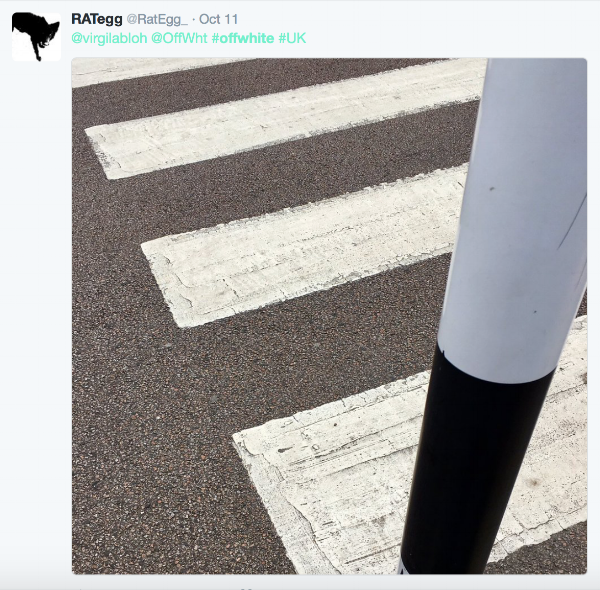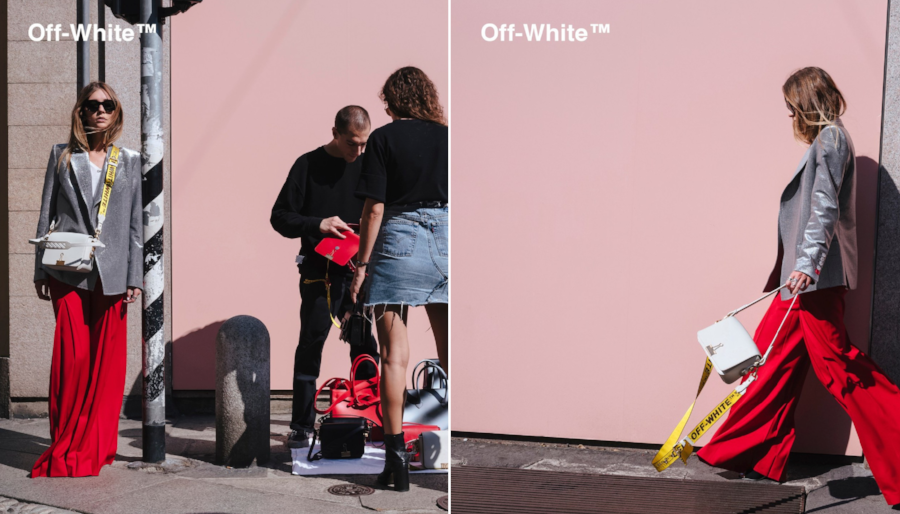It is difficult to deny the sheer force that has catapulted Off-White to the forefront of the minds of young, hip, fashion-focused consumers. Much has been made of Virgil Abloh, the mastermind behind the Milan-based brand, in the press since he launched Off-White in 2014 after garnering fans with his (now-defunct) streetwear brand, Pyrex Vision. There is no shortage of lengthy articles devoted to both ventures, and to Virgil Abloh, himself, particularly given his ability to step out of the shadow of early creative partner Kanye West, and climb to the top of the luxury goods industry.
Our focus is not on the rise of the Off-White brand, though, or on Abloh’s footprint in the worlds of streetwear and high fashion. It is, instead, on Abloh’s use of existing graphics to build a brand that resonates with consumers, and whether he will be able to rely on trademark protection in connection with those very graphics.
Abloh’s most noteworthy offering comes in the form of his brand’s logo – the diagonal line motif that is not in any way exclusive to Off-White. It is the graphic you find on cross-walks and on road signs – and have found there for many decades now, certainly long before Off-White’s inception. As a brand builder, Virgil Abloh did something very interesting here. Instead of utilizing a distinctive brand-identifying logo, which is what the vast majority of brands tend to do (save for maybe Target with its bull’s eye logo or Rolex with its stylized crown), he chose one that is completely unoriginal.
Off-White: The Upsides of Ordinary
The co-opting of a nearly universal design for use on t-shirts, sweatshirts, trousers, jackets, shoes, and bags comes with significant benefits and drawbacks. On the upside, Virgil Abloh has been able to piggyback off of an extremely common and well known design. “Off-White’s designs—brash and loud and graphic, branded with black-and-white diagonal stripes you can recognize from 30 yards away—are everywhere,” Zach Baron wrote for GQ.
Writing for Complex, Cameron Wolf put the power behind this move best: “Even if the general population doesn’t recognize those diagonal stripes as Abloh’s, if his followers do, then he’s succeeded. Imagine hundreds of thousands of Off-White fans seeing diagonal lines all the time and automatically thinking of Abloh’s label. That’s extremely powerful because it can make the brand seem larger than it actually is.”
In this way, Virgil Abloh has put the street to work for him – sometimes very literally – in creating brand awareness in lieu of having to spend on traditional forms of advertising, such as pricey campaigns or particularly over-the-top runway shows.

Worthy of Protection?
The less advantageous element of this equation stems from the chance that Virgil Abloh will be unable to solidify a connection in the minds of consumers between the diagonal stripe design and his brand’s goods because the logo is based on a largely generic design. With this in mind, Virgil Abloh may experience a potential inability to obtain trademark rights in his logo – and thereby prevent others from using it in connection with their own brands in a way that is confusing to consumers, which is one of the benefits of trademark protection.
The legally-minded amongst us know that in order to receive federal trademark protection, the mark at issue must be distinctive – either inherently or as a result of creating a connection (or “secondary meaning”) in the minds of consumers between the trademark and the brand at issue, a phenomenon known as acquired distinctiveness. In other words, the trademark must be capable of identifying the source of a particular product.
“The name of the game in trademarks is distinctiveness. Basically, the marching orders at the Trademark Office are that, with very few exceptions, distinctive marks [either inherently distinctive ones or those that have acquired distinctiveness] will be registered. So, if your mark distinguishes your stuff from similar stuff made by others, then it may very well be a good candidate for registration,” says Ed Timberlake, a board certified Trademark Law Specialist and former Trademark Examining Attorney at the U.S. Patent & Trademark Office (“USPTO”). In short, the mark “should be different from what others are doing in and around your market space.”
Luckily for us, whether or not Abloh’s diagonal line logos are worthy of trademark protection will not be a mystery for very long. As of this past July, Virgil Abloh filed trademark applications for registration for a few variations of his Off-White brand’s logos.
For the uninitiated, it is worth noting that the filing of trademark applications does not guarantee that the trademarks will be registered with the USPTO and thus, granted federal trademark protection. As such, the question – or better yet, one of the questions – is “whether the symbols are being used in connection with this stuff in such a way that people will make the connection between the symbols and this stuff so as to understand that any of these particular symbol-stuff combinations come from this particular source,” says Timberlake.
So, what about Abloh’s marks? The three marks are described in the trademark applications as follows:
· One is for a mark “consist[ing] of fifteen alternating parallel diagonal lines of varying sizes forming the shape of a rectangle,” and was filed in class 35, which extends to “Retail store services” and “online store services … featuring apparel, footwear, accessories, [and] home furnishings,” among other things;
· Another proposed mark “consists of fifteen alternating parallel diagonal lines of varying sizes forming the shape of a square,” which was filed in classes 18 (bags) and 25 (apparel for men and women); and
· Lastly, there is a mark that “consists of nineteen alternating parallel diagonal lines of varying sizes forming the shape of a rectangle,” which was also filed in classes 18 (bags) and 25 (apparel for men and women).
 Abloh’s three Off-White trademarks (images courtesy of USPTO)
Abloh’s three Off-White trademarks (images courtesy of USPTO)
The “symbols” at issue are thus, the diagonal line logos. The stuff: retail store services, apparel, bags, footwear, etc.
The black and white stripe designs that adorn Abloh’s wares are one of the garments’ prime selling points. This is great for Abloh’s bottom line, as it leads to the sale of anything and everything with the brand’s prominent design on it. However, it may be problematic in a trademark sense, as when the mark is actually the principal decorative feature of the product, courts sometimes hesitate to grant broad trademark or trade dress protection, as doing so would stifle legitimate competition. This is the aesthetic functionality doctrine – which exists to stop a party from obtaining exclusive trade dress or trademark rights in the functional features of a product or its packaging – in a nutshell.
In the context at hand, since the stripes that appear on Off-White garments arguably serve a significant non-trademark function (aka: they are used to make the garments or bags look more appealing or prominent), the feature might not be protected as a trademark. Per Alexandra Roberts, an Assistant Professor at the University of New Hampshire School of Law, who teaches and writes about intellectual property, among other topics, “the marks would probably fail under an aesthetic functionality analysis.”
Speaking of federally-protected designs, she says: “Registrations like Burberry’s plaid are the exception, not the rule; black and white stripes is the kind of common pattern that we expect competitors would want the ability to use simply because it looks good, and not because it serves a source-indicating role.”
While Abloh’s marks may be aesthetically functional, not all hope is lost in terms of obtaining trademark protection. There is a chance that his applications will result in registrations, but only if Virgil Abloh can establish that due to his use of the logos in connection with Off-White brand goods, consumers recognize logos as the source of his brand’s goods.
Because the trademarks claimed in Abloh’s applications for registration are based on what Roberts describes as “a pattern [that] is particularly basic. It’s essentially black and white stripes, which are everywhere,” he will have to present evidence that the trademarks have acquired distinctiveness. This may not be impossible for Abloh to do.
“When I type [Off-White] into Google images I see really prominent use that, if widespread enough, could perhaps acquire distinctiveness and come to serve a trademark function among consumers,” Roberts says. She further claims that “functionality and ornamentality/failure to serve as a mark would be enough to keep the owner from successfully asserting the designs constitute protectable matter (and in theory, should trump secondary meaning even if it exists), [the USPTO examining attorneys] often work backward and find that if there’s secondary meaning then there must also be legitimate use deserving of [federal trademark] protection.” This is good news for Abloh.
Timberlake seems relatively optimistic in terms of the strength of Abloh’s marks, as well: “My own feeling is that they’re doing a good job both from a fashion standpoint and a trademarks standpoint, which is to say, they’re getting noticed. The bold, black diagonal lines are easily perceptible and quite noticeable.” He further stated: “The more they use them, the more people may start to associate bold, black diagonal lines in the (somewhat expensive) clothing context with Off-White.” And when it comes to trademarks, that is what matters: Consumers making the connection between a brand’s logo and its goods.
The applications are pending before the USPTO as we speak, with Virgil Abloh still needing to submit examples of how he is using the logos in commerce. Brian Igel, the attorney of record for Abloh’s trademark applications, was unable to comment for this article, but given that the applications were just filed in July, will likely be months before we have definitive answers. So, stay tuned.
Regardless of how these legal matters play out, Abloh’s ability to build a compelling brand is undeniable – and while rumors in the past regarding the designer landing at the helm of a big-name house have yet to play out, it really is only a matter of time before they do.
* This article was initially published in November 2016.











